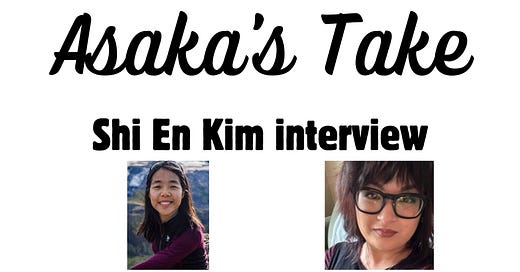Asaka's Take: Science writer Shi En Kim
What is it like to go from Cal Tech to a career as a journalist?
Mark Simon here … We have a student from The College of New Jersey helping us out. Asaka Park is a senior journalism major who is building a career as a freelance writer covering lifestyle, culture, and wellness. She writes about Gen Z life, (in)visible disabilities, and finding silver linings amidst the shades of grey.
Here, she’ll be writing comprehensive episode summaries, providing her take on what she found most interesting in the interviews. She’ll also be helping us out behind the scenes.
This interview that Asaka is recapping is with science writer Shi En Kim, who has covered everything from the world’s stinkiest flower to access to precision cancer drugs.
According to a survey by The American Journalist, 96% of full-time journalists have a bachelor’s degree; 60% of them have majored in journalism or communication. The other 40% includes someone like Shi En Kim, who has taken the time to immerse themselves in a subject before bringing their expertises to the masses.
Shi En Kim, a science writer, has a B.S. in chemical engineering from California Institute of Technology, and a PhD in molecular engineering from the University of Chicago. Her articles have appeared in major publications such as National Geographic, Scientific American, and Smithsonian Magazine.
Currently, she is working on a Pulitzer-funded reporting project which will take place in Brazil.
“I will admit that the project is still in its very early stages. I haven't finalized the travel dates or the logistics yet, but I think that's how all projects are,” she says.
Here are the 5 main takeaways from her conversation with Mark.
1. Being a STEM major at a top university is as rough as it sounds.
Enrolling the California Institute of Technology was “the first crack in [her] self confidence that [she] could be a scientist,” says Kim.
“It’s easy to be a very good science student in high school. Bring a bunch of pretty smart kids from all around the world there. You quickly realize that maybe you're not the smartest,” she tells Mark.
The second crack struck in grad school, when Kim found herself studying a nanomaterial called molybdenum disulfide, or MOS2.
“It's a nanomaterial that's all the rage in the semiconductor industry. And that was my bread and butter,” she says.
But when a family member asked her, “What is MOS2 and why are you studying it?”, she found herself grasping for words.
“Something was really wrong my ability to articulate information. So I decided to compensate for that by pursuing, by doing some science writing on the side to help with my communication skills.”
So you can say that my journalism career really has been just one long overcorrection to my inability to answer the question, ‘What is molybdenum disulfide?’
— Shi-En Kim for The Journalism Salute
2. A niche in science writing gave Kim a new lease on her academic track.
Kim got an internship for University of Chicago’s Hospital's At the Forefront blog. Every Tuesday for three months, she wrote articles about her university’s advancement in medicine and biology.
“Tuesdays was one of my favorite days for that entire period of the internship,” she recalls.
Even though she wasn’t paid, the experience proved to be a pivotal moment in her career.
“After the end of my internship, I begged to stay on. They wouldn't let me, which I'm so thankful for that.”
3. Putting in extra work outside of class allowed Kim to successfully transition from a background in science to a career in journalism.
Over the next several years, Kim juggled grad school with interning for publications and freelancing articles. Once she got her Ph.D., Kim started working for Chemical and Engineering News magazine as a staff writer. After a year, she opted to freelance full-time.
“My family was a little nervous for me when I started out, but I think I've convinced them that I can make it work financially,” she says.
Like Mark says, her portfolio runs the gamut. From the fairness of coin flips — tune in for the verdict — to simulating alien communication, her topics span from the mundane to the not-so-mundane.
Kim tells Mark about interesting conversations she’s had with her sources. Her favorite, she says, took place when she was writing an article on artificial life.
“When I was speaking to this researcher, he was so tired of answering, ‘What is the merit of artificial life’? And he admitted, ‘I'm not the first one to have said it’ [but] gave me this quote, ‘What is the merit of your grandmother? What is the merit of your dog?’ Which I thought was ridiculous. And I love that quote. I had to fight to have to keep that quote in my article, but I'm so glad that I did.”
4. Don’t underestimate the power of “single-study stories”, aka news articles based off of a new finding or a study.
Kim typically approaches writing articles by “Taking the macro and making it a micro story.”
When Kim saw a new study that came out that said since nearly 50 percent of new cancer drugs since 1998 are classed as “precision drugs,” she thought about what this means for families navigating cancer treatment: How does one “qualify” for the 50 percent? Is 50 percent a lot or not enough? Who is being left behind, and what’s in the books for them?
Precision drugs are prescribed to match the individual’s genetic makeup.”
“Precision medicine seems very buzzword-y, it's getting a lot of traction and lots of investments are pouring to them,” she explains. “But are people exploring other cancers that have a different kind of genetic signature that maybe the minority has?”
You can read her findings here.
5. Kim looks forward to exploring different parts of the world.
Her upcoming Pulitzer-granted reporting project will take place in Brazil.
“I wanted to challenge myself to step outside my comfort zone and do something I've never really done before, which is to pursue bigger projects that really require me to travel and be a real fish out of water,” she tells Mark.
The project is based off of a study that came out in Brazil (to learn more about the topic, tune in).
Currently, Kim has been busy “pre-interviewing” the researchers who authored the study and other experts in the field. She says she wants to take the time to build rapport with her sources.
“I do want to try to avoid parachute journalism, meaning coming in and trying to report on a story that I don't know much of,” she explains.
She was particularly excited to hear from a Brazilian expert who was able to speak on the “nuances of what it’s like living there.”
Kim says that growing up in Malaysia gives her a more globally-minded perspective.
“Sometimes I really interrogate my experiences of growing up in a country that with rich tropical wildlife that the outside world would call ‘exotic’, but […] is quite well known to us and we don't see as ‘exotic’.”
Case in point, Rafflesia, the world’s biggest and stinkiest flower, is more common in Indonesia, but can also be found in Malaysia. Kim has written two articles about the parasitic flower, which is facing endangerment due to deforestation and poaching.
While researching, Kim managed to get a hold of scientist Sophie Mursidawati, who she believes is the first person to successfully grow a rafflesia outside the rainforest. Out of all the people who have claimed to done so, she reckons, Mursidawati is the only one who has “established protocol and was willing to share it with the world.”
Whether it’s translating dense journal articles for average Joes and Janes, or highlighting the contributions of scientists from the Global South, Kim says she wants to represent the diversity of the human experience.
“My favorite kind of stories are those local stories that can be lessons that can be extended to other countries,” says Kim.
“I'd love to one day move back home for a few months, and maybe go around the country, my home country [Malaysia] to search for stories, but that hasn't happened yet. Maybe one day it will.”
— Shi En Kim for the Journalism Salute





